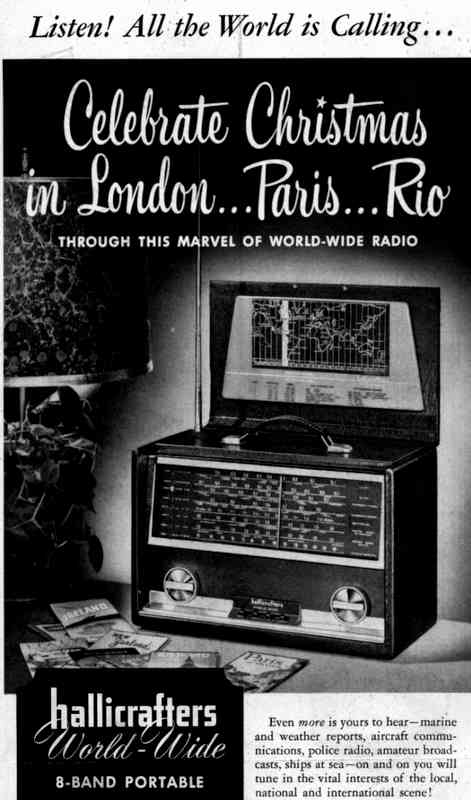
Hallicrafters TW-1000
The first of the 8 band Hallicrafters "Transoceanic clones"
The Hallicrafters TW-1000 "World-Wide" is another Zenith Transoceanic "clone" that is rather well-made. It is electrically identical to the Hallicrafters TW-2000 repaired earlier except for the use of a lid-mounted loop antenna in place of the chassis-mounted ferrite rod on the TW-2000. The TW-1000 is assumed to be the earlier production model. The TW-1000 was replaced by the TW-1000A which replaced the lid-mounted loop antenna with a chassis-mounted ferrite rod. The TW-2000 also has the later chassis-mounted ferrite rod. All three models, the TW-1000, TW-1000A, and TW-2000 also use a "Skyrider antenna", a ferrite rod for the movable broadcast and VLF antenna. The shape of the TW-1000 case is very similar to the rectangular boxes of the Zenith Transoceanics. However, the TW-1000A and TW-2000 have a case with a slope on each side so that the top is slightly narrower than the bottom of the case. The TW-1000A and the TW-2000 have plastic folding handles similar to that of the Transoceanics. The TW-1000 came with a leather handle.

The three Hallicrafter models each cover 8 bands, one more than comparable Transoceanics. These cover the standard AM broadcast and two continuous shortwave bands from 1.8 MHz to 8 MHz as well as the 16, 19, 25, and 31 meter international shortwave "spread" bands. Unlike the Zeniths, the Hallicrafters models also cover the VLF band from 180 to 400 KHz.
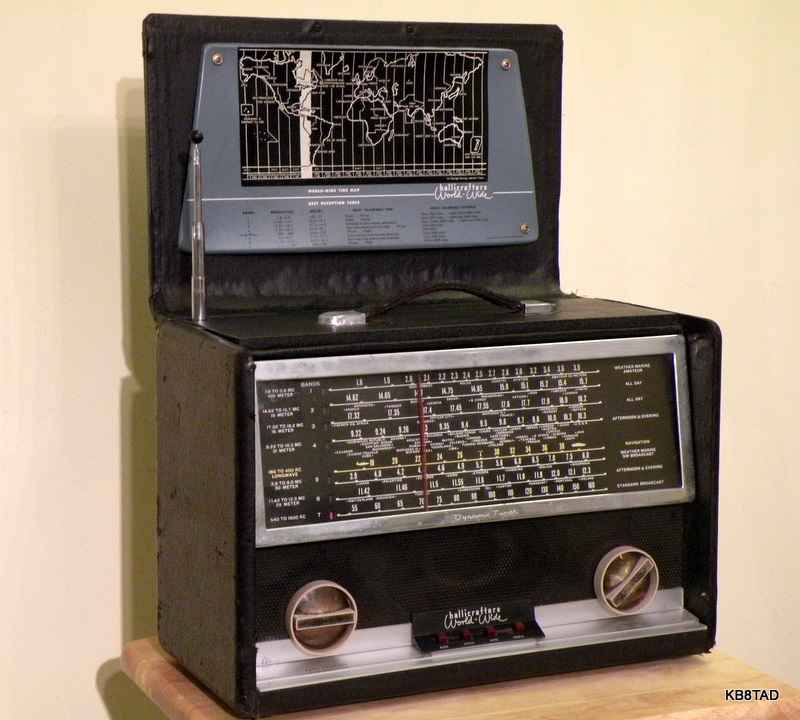
I assume that the TW-1000 was the earliest model followed by the TW-1000A and then the TW-2000 followed by the TW-2000 run 2. There seems to be a logical progression that should correlate with production dates. However, the Hallicrafters reference and resource sites list all three models as being produced from 1952 to 1956. The original price of the TW-1000 in U.S. dollars was $149.95.
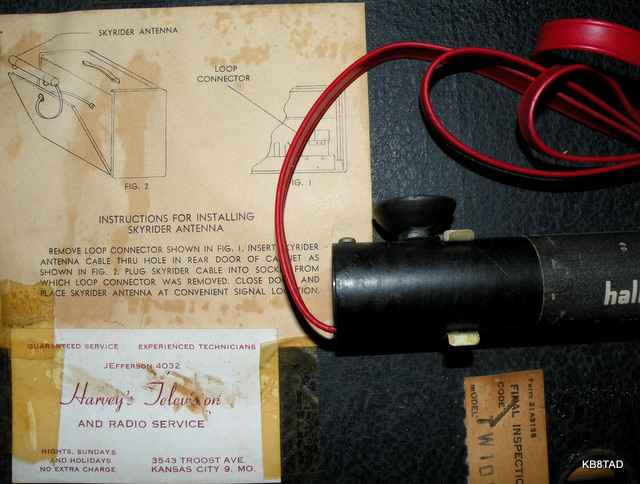
This particular set was likely used in or around Kansas City, Missouri. A business card for Harvey's Television and Radio Service was taped inside the back lid. It's possible they sold the radio to its first owner.
Repair notes: The Usual Suspects
This TW-1000 did not work at all when purchased at a swap meet. It was also in serious need of a good cleaning so the first step was a thorough scrubbing with white waterless hand cleaner and old soft tooth brushes. After pulling the chassis which is removed complete with the front panel, I noticed that the set still had its original selenium rectifier, a known problem. I then did the usual ohmmeter checks for safety and to verify the volume control switch and the special battery/ AC switch that is activated when the AC plug is inserted in the chassis. Continuity between one side of the AC plug and the grounded shell of the electrolytic caps was intermittent. I suspected the sealed volume control switch but the problem turned out to be the AC-battery switch which was promptly cleaned with deoxit. That solved the intermittent. It is important to check continuity for both the volume control power switch as well as the AC/ Battery switch since poor contact in those switches is a common problem in long-dormant sets.
I then located the large 2000 ohm 10 watt voltage dropping resistor that feeds the filament chain beginning with pin 7 of the 3V4. The resistor was intact. A proper level of resistance from the 3V4 pin 7 to the electrolytic ground shells indicated that the series filament chain was also intact. I clipped a digital voltmeter to those two points so I could monitor the filament voltage. A second voltmeter was connected to the output of the selenium rectifier and the electrolytic shell ground. I then slowly powered up the unit with my isolated variac while monitoring the voltmeters and the current draw. As expected, with full line voltage applied, the voltmeters read too little filament and B+ voltage to properly power the set. While the set was working somewhat on powerful stations, the filament chain could barely get to 6 volts with AC voltage input of 125. The solution was to substitute a 1N4007 silicon diode with an additional series resistor. A weak selenium rectifier is a common problem in Transoceanics and clones.
I removed the selenium rectifier to have enough room to mount a new terminal strip with the diode and the series resistor. I experimented with various resistances and the variac in order to supply about 8.0 volts plus or minus a quarter of a volt for typical AC line voltages. The Hallicrafters circuit with its two filament string series chokes specifies 9 volts for the full filament chain but I prefer to have a reduction in that voltage of about 10 to 15 percent to lengthen the life of the increasingly expensive tubes and to provide a bit of margin for rising line voltages. With a good 1L6 such a voltage level should be no problem. I ended up adding a 68 ohm two watt resistor.
Critical capacitors were checked and changed as needed especially the 0.05 MFD line voltage capacitor which should always be changed with one rated for line voltage in any Transoceanic or clone.
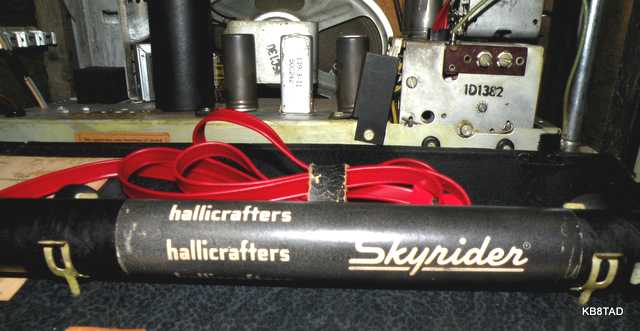
While testing, I was working with a length of wire for an antenna. I then connected the portable ferrite rod antenna (the Skyrider antenna) but that caused hum and strong distortion. A continuity check of the Skyrider antenna showed it to be open circuit. I opened the Skyrider antenna. Inside is a ferrite rod about 8 inches long in parallel with a small adjustable variable cap. Luckily, I found a bad solder joint right at the variable cap. Re-soldering restored the antenna's continuity and provided proper operation for the broadcast band. Breaks and opens at the various movable antenna connections is another common problem in Transoceanics and clones.
Alignment
Although I tweaked a couple of adjustments, it was apparent that a major alignment was not needed in this set. The alignment of the turret-mounted coils is a rather involved process and the probability of prior tampering with alignment is low in these Hallicrafter sets. For alignment info, see the notes on the Hallicrafters TW-2000 .
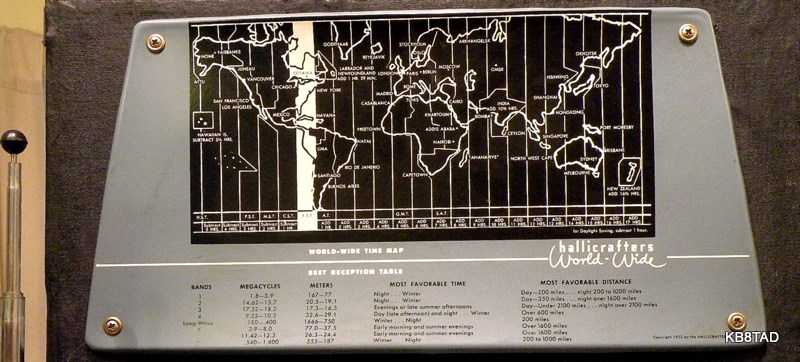
an improved Transoceanic
The performance of this TW-1000 did not disappoint me. Like the TW-2000, performance was definitely on par with the fine short-wave and broadcast reception that I have come to expect from a properly performing Transoceanic. I consider these Hallicrafter sets to be improved Transoceanics in many respects, not just clones. For a comparison of the Hallicrafter sets and tbe Transoceanics, see the notes under the Hallicrafters TW-2000 .
Comments from a user of the TW-1000 in the 1950s
Being an early post-war baby, we would play "Flying Saucer" and listen to some of the high pitched signals that sounded like what you heard on Buck Rodgers. My younger brother lives in the family home and the radio had been put away decades ago. I told him to get it out next week so we could evaluate it.
You are going to love this. The model you show with the "Harvey's Radio" card on the back is what caught my attention. He was the radio shop in our neighborhood in KC and worked on my family's items on more than one occasion! We could walk to this shop in a few minutes. He wasn't retail, but just did repairs and sold used units. I haven't thought about him in ages and I believe that he moved away before the 1960's.
Harvey got a lot of his parts at Henshaw's Electronics that was half a block down Troost Ave. They are still in business after 75+ years, just a little farther away.
Best regards,
Charles H
1-2-2010; Update 1-28-2010
The UEI 301 Scope meets Radio Shack TK-100 signal generator were the previous items on the bench.